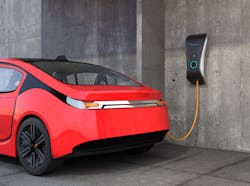BOMA 2023 Preview: Is Your Property EV-Ready?
The poised explosion of electric vehicle adoption is driven by government incentives and the increasing availability of reliable places to charge those vehicles. Does your property have the charging infrastructure needed to accommodate them?
EV infrastructure manufacturers are prepared to help building owners and managers answer that question at the 2023 BOMA International Conference & Expo. Among the exhibitors on the trade show floor are EV solution providers AmpUp and FLO. AmpUp is exhibiting for the first time, while FLO is making its third BOMA appearance in 2023.
“It’s an amenity that folks are looking for,” said Lanie Meyers, director of marketing for AmpUp, an EV charging software solution provider. “If you have a parking lot for any other vehicle, your property will need EV chargers for people to charge up.”
What You Need to Know About Installing EV Infrastructure
When you’re thinking about installing EV chargers at an existing property, it’s crucial that you reach out to your utility and an electrician first. You’ll need to have your property surveyed, and if you don’t have existing EV infrastructure, you’ll have to lay the groundwork before you can put in chargers.
Electricians will look at a variety of factors at each site, explained Matt Bloom, director of business development for AmpUp, including panel size, the distance from the panel to the parking spaces and what future-proofing infrastructure should be installed for future chargers.
“In some cases, your electric panel may have enough capacity to add on your first two or four charging stations, as well as be close to the parking spots where the chargers would be installed,” Bloom said.
The type of charger you want to install could also affect whether you need to make site upgrades. Level 2 chargers take longer to charge vehicles, but they also don’t draw power quite as intensely. DC fast chargers can charge vehicles faster, but also tend to cost more than slower chargers.
You’ll need to understand the charging needs of your intended audience to understand which type you need, advised Cory Bullis, public affairs director for FLO, an EV charging station manufacturer and network operator. If you have office or multifamily properties where people will park for several hours, you may want to put in some Level 2 chargers, while people who are in and out of your business in 15-30 minutes will gravitate toward a DC fast charger.
You should also ensure that your charging vendor has a robust reputation for reliability and continual uptime, Bullis said.
“You can do all the investment you want, but if the chargers are breaking or malfunctioning and not providing a high level of service to drivers, it minimizes the value of the investment,” Bullis added. “Really focus on reliability as one of the key value propositions for any product from any company in the charging space.”
5 Top Considerations for Charging Installations
No matter which charger type you opt for, you’ll need to have an idea of how you want to operate the charging stations once they’re installed.
1. Where will you put the chargers? Do you want them in the back of the parking lot, the front or both? “Depending on where you choose those spots, it’s going to affect whether you have accessible utility infrastructure you can leverage,” Bullis said.
2. Who gets to use the charger? Is your charging station open to the public or is it reserved for tenants, clients and employees?
3. Will people have to pay for charging? Do you want to offer free charging as an amenity, or will you charge people for the power they’re using? If you’re charging, how much will people pay? Some manufacturers allow you to have different charging permissions for different people, so tenants and their employees could pay one rate and the public could pay another rate, noted Meyers.
4. How long can people stay to charge? With a Level 2 charger, it can take hours to recharge a vehicle whose battery is nearly depleted. A retail location, for example, might want to set limits for how long people can use the charger.
5. Can you reserve a charging station? “This makes it easier for drivers to find public stations,” Meyers said.
Take Advantage of Incentives
There’s no better time to install electric vehicle chargers. That’s because there are several incentives available to defray the cost of putting in the infrastructure, Bullis said. The federal government made public dollars available for building owners to put in electric vehicle chargers through the Bipartisan Infrastructure Law and the Inflation Reduction Act, and many states and municipalities have their own incentives as well.
Charging infrastructure vendors are likely familiar with the process of applying for these incentives, and your utility may be able to help, too.
“Yes, EV charging is a newer technology, but it’s coming at us faster and faster,” Bullis said. “The opportunity is now to take advantage of the resources available to folks to do these investments. It’s an exciting time.”
Check out the show floor at the 2023 BOMA International Conference & Expo in Kansas City, Missouri, this June. Click here to register!
About the Author
Janelle Penny
Editor-in-Chief at BUILDINGS
Janelle Penny has been with BUILDINGS since 2010. She is a two-time FOLIO: Eddie award winner who aims to deliver practical, actionable content for building owners and facilities professionals.

